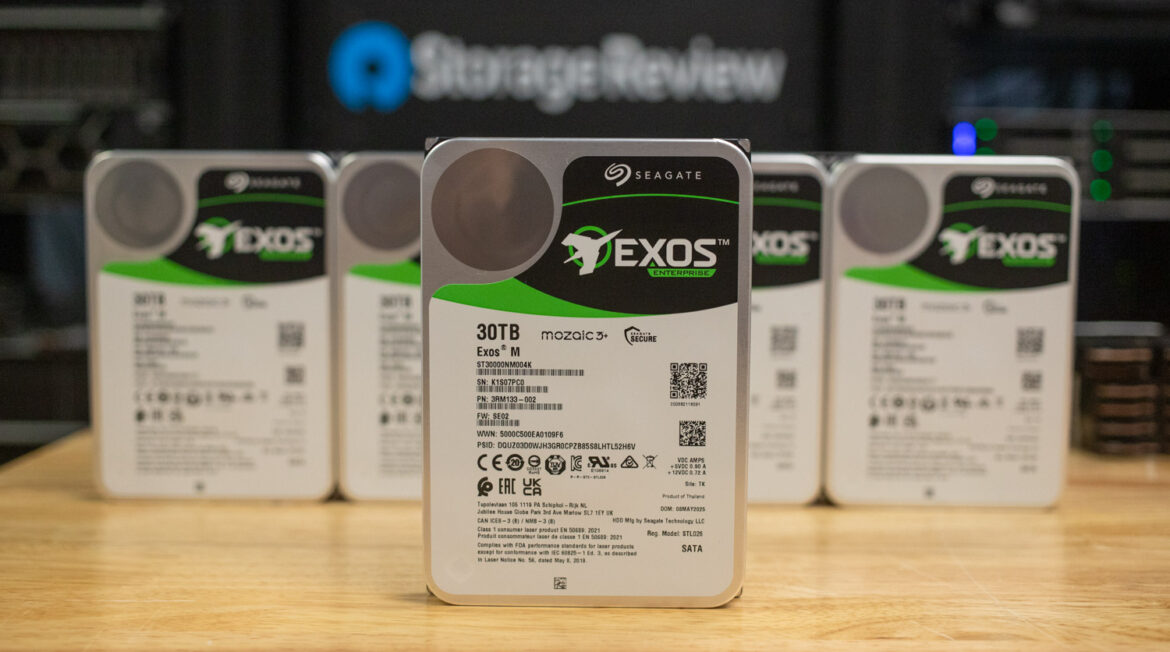The Seagate Exos M 30TB HDD delivers groundbreaking capacity, performance, and efficiency for hyperscale, AI, and cloud storage environments.
Seagate’s Exos M 30TB is the company’s newest high-capacity enterprise HDD, engineered to meet the growing demands of AI, hyperscale storage, and data-intensive cloud environments. As the industry’s first drive to feature 3TB per platter, the Exos M achieves a massive 30TB of raw storage capacity in a familiar 3.5-inch form factor.
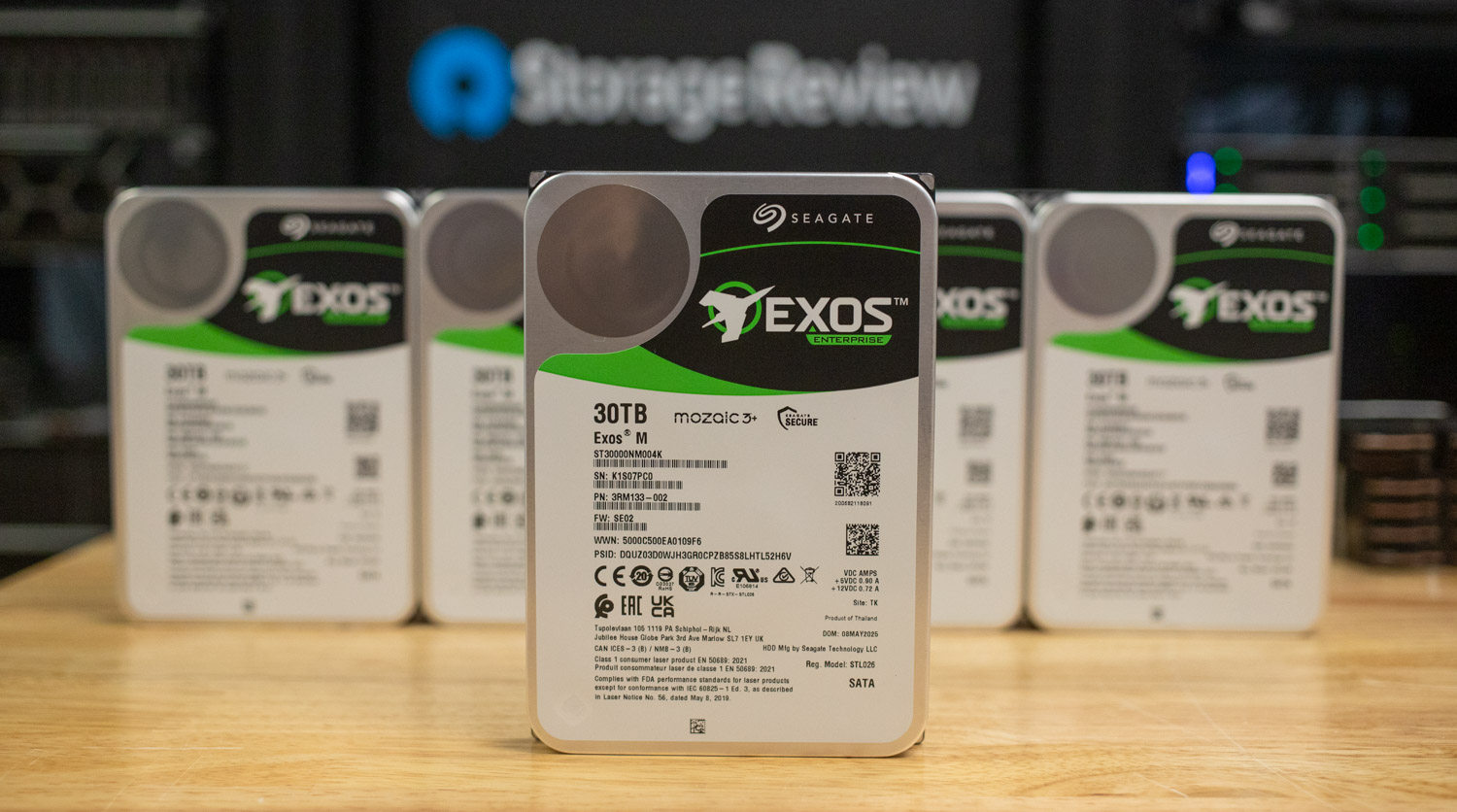
This latest addition to the Exos family emphasizes more than just capacity. Built on Seagate’s Mozaic 3+ platform, the drive is designed for greater power efficiency, improved cooling, and long-term sustainability, all while preserving backward compatibility. These advantages make the Exos M especially compelling for modern enterprise deployments that prioritize both scalability and efficiency.
We received a few Exos M 30TB drives in our lab to see how this new drive performs under mixed workloads. Although it’s optimized for hyperscale and AI use cases, we subjected it to our standard suite of consumer and enterprise HDD/SSD benchmarks to evaluate its real-world behavior in a range of scenarios.
Seagate Exos M 30TB Features
The Exos M 30TB builds on years of enterprise-class development, introducing a platter density breakthrough with its 3TB-per-disk configuration across 10 platters. This results in a 30TB total capacity without increasing the drive’s physical size, allowing dense storage arrays to scale vertically without infrastructure changes.
You can spot what makes this drive different just by looking at the label. A warning for “Class 1 Laser Product” is printed clearly on the drive, an unmistakable indicator that this is a HAMR-based drive. The real magic behind this capacity leap is Seagate’s Mozaic 3+ platform, which leverages HAMR (Heat Assisted Magnetic Recording) technology to push areal density well beyond the limits of conventional CMR. HAMR uses a precision laser to momentarily heat the media surface, allowing data to be written to much smaller regions with greater precision. This is what enables the 3TB+ per platter design and even higher capacities to be realized at scale. We explored this breakthrough in detail during Podcast #124 featuring Seagate’s Colin Presly, where we discussed the long-term roadmap and technical evolution of HAMR.
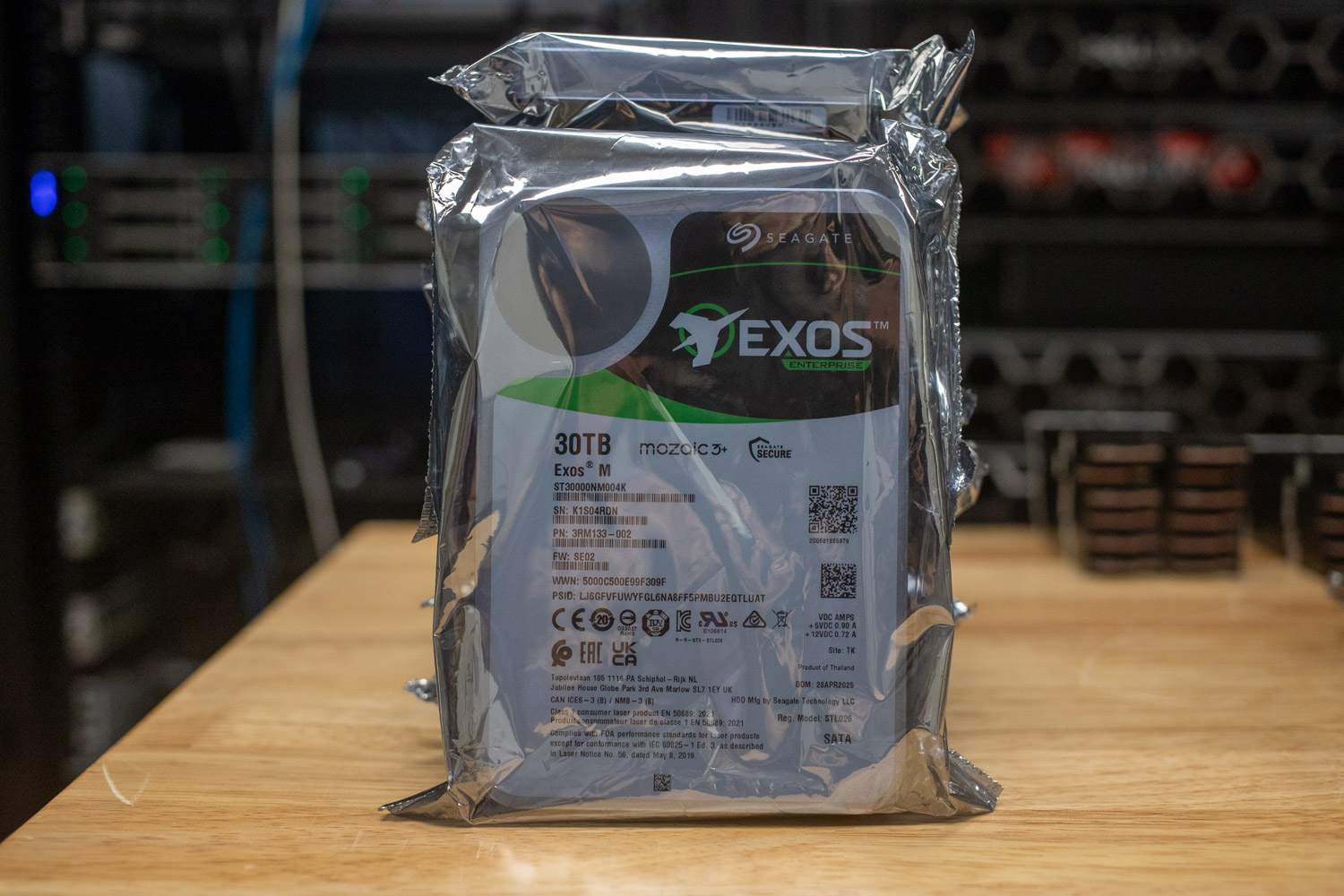
Power efficiency is a major focus. Seagate claims up to three times the power efficiency per terabyte compared to traditional enterprise HDDs, which could translate to significant savings in power and thermal budgets at scale. The drive is also engineered for better thermal behavior, helping reduce the need for additional cooling in tightly packed deployments.
From a compatibility standpoint, the Exos M uses the same form factor, interfaces, and cooling requirements as prior Exos models, making it easy to deploy across existing platforms. Internally, the drive maintains high reliability and consistency for data center workloads with its robust build and sustained throughput optimizations.
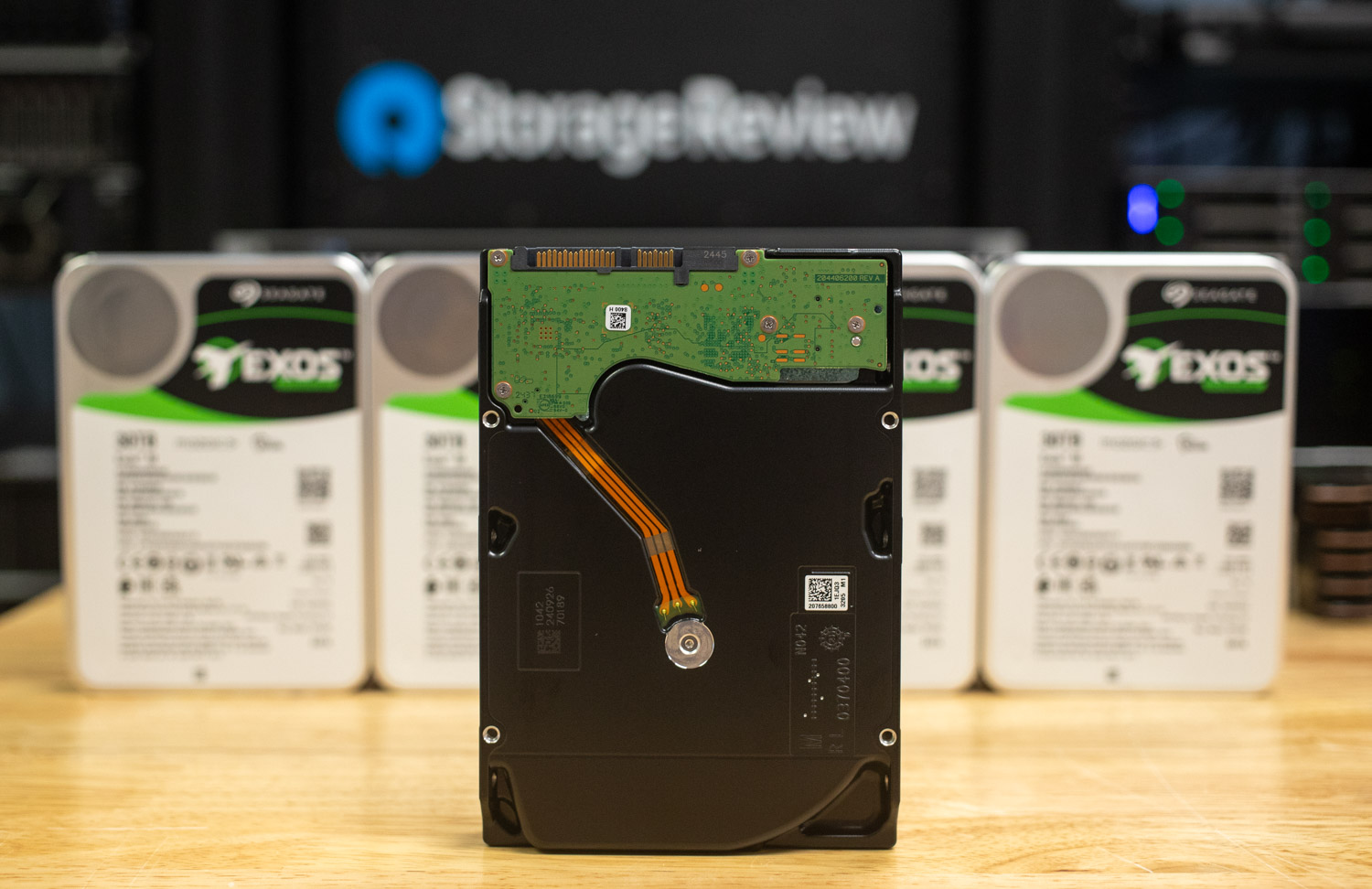
Sustainability is also a key theme. According to Seagate, the Exos M uses more recycled and renewable materials than any previous product in its class, contributing to enterprise sustainability goals without sacrificing reliability or performance. Security is built in as well, with Seagate Secure providing onboard data protection to safeguard sensitive workloads.
Seagate Exos M 30TB Reliability
The Exos M series continues Seagate’s legacy of building drives for mission-critical, always-on environments. It incorporates over 90 percent of proven components from previous enterprise designs, reducing the risk of untested variables in production environments.
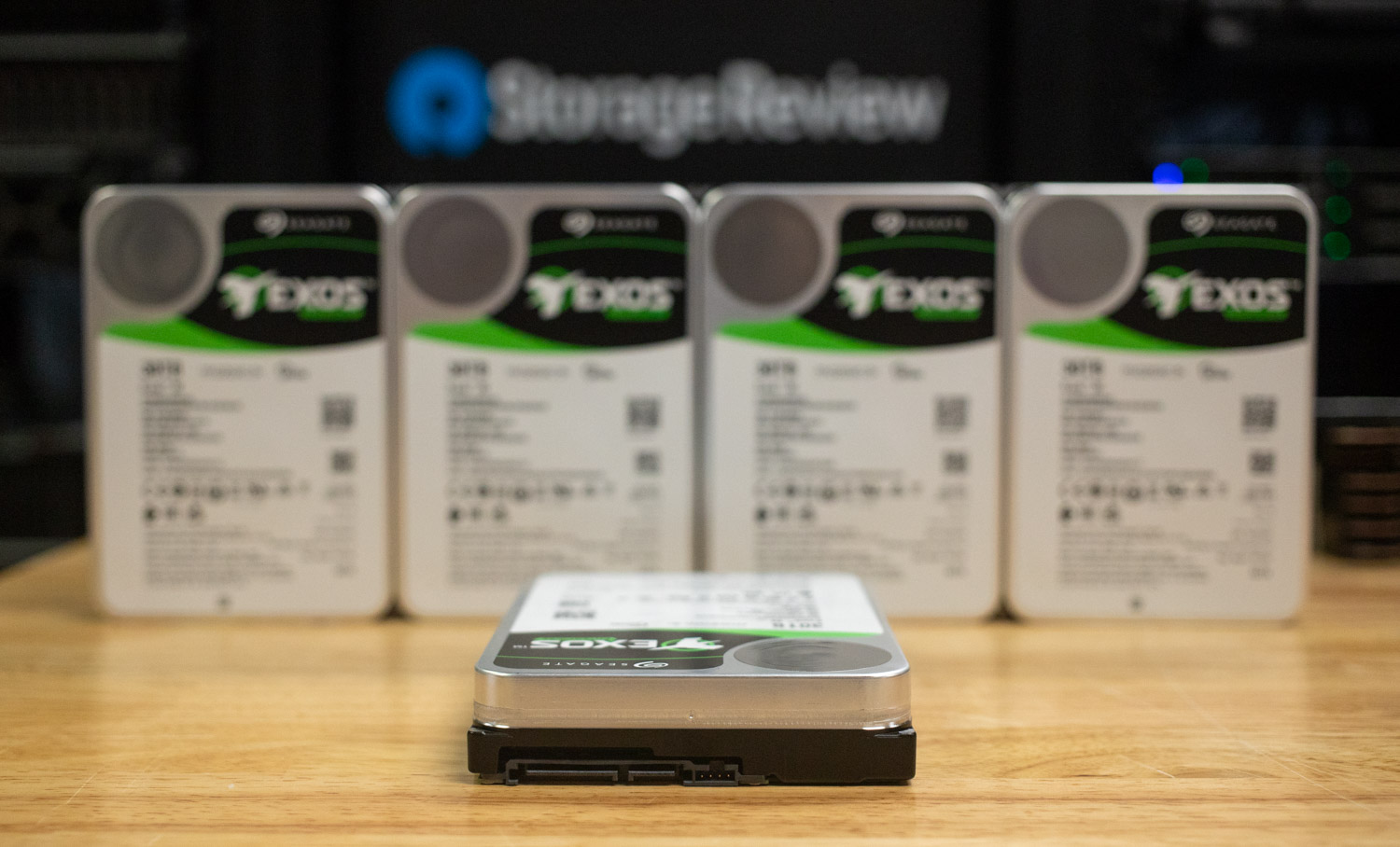
As with other drives in the Exos enterprise lineup, the 30TB model is rated for 2.5 million hours MTBF and comes with a five-year limited warranty. These figures place it firmly in line with other mission-critical drives used in hyperscale and data center environments, where continuous uptime is a core requirement.
Specifications
The table below outlines the key technical specifications of the Seagate Exos M 30TB, including its performance capabilities, physical characteristics, power requirements, reliability metrics, and supported technologies for enterprise-grade deployment.
| Specification | Details |
| Product Name | Exos M |
| Capacity | 30TB |
| Standard Model | Seagate Instant Secure Erase (ISE) – 512e (ST30000NM004K) |
| CMR | Yes |
| Helium Sealed-Drive Design | Yes |
| Super Parity | Yes |
| Low Halogen | Yes |
| PowerChoice™ Idle Power Technology | Yes |
| PowerBalance™ Power/Performance Technology | Yes |
| Hot-Plug Support | Yes |
| Cache, Multisegmented (MB) | 512 |
| Organic Solderability Preservative | Yes |
| RSA 3072 Firmware Verification (SD&D) | Yes |
| Mean Time Between Failures (MTBF, hours) | 2.5M |
| Reliability Rating at Full 24×7 Operation (AFR) | 0.35% |
| Nonrecoverable Read Errors per Bits Read | 1 sector per 10E15 |
| Power-On Hours per Year (24×7) | 8760 |
| 512e Sector Size (Bytes per Sector) | 512e |
| Limited Warranty (years) | 5 |
| Spindle Speed (RPM) | 7200 |
| Interface Access Speed (Gb/s) | 6.0, 3.0 |
| Max. Sustained Transfer Rate OD (MB/s) | 275MB/s / 262MiB/s |
| Random Read/Write 4K QD16 WCD (IOPS) | 170 / 350 |
| Average Latency (ms) | 4.16 |
| Rotation Vibration @ 20-1500 Hz (rad/sec) | 12.5 |
| Idle A (W) Average | 6.9W |
| Max Operating, Random Read 4K/160Q (W) | 9.5W |
| Power Supply Requirements | +12V and +5V |
| Temperature, Operating (°C) | 10°C – 60°C |
| Vibration, Nonoperating: 2 to 500Hz (Grms) | 2.27 |
| Shock, Operating 2ms (Read/Write) (Gs) | 50 |
| Shock, Nonoperating, 2ms (Gs) | 200 |
| Dimensions | H 26.1 (mm) W 101.85 (mm) D 147.0 (mm) |
| Weight (g/lb) | 850g / 1.52lb |
Seagate Exos M 30TB Performance
Before diving into the benchmarks, here’s a list of comparable capacity HDDs used to evaluate the performance of the Seagate Exos M 30TB, including the newly released Seagate IronWolf Pro 30TB.
The high-performance test rig we used for storage benchmarking includes:
- CPU: AMD Ryzen 7 9800X3D
- Motherboard: Asus ROG Crosshair X870E Hero
- RAM: G.SKILL Trident Z5 Royal Series DDR5-6000 (2x16GB)
- GPU: NVIDIA GeForce RTX 4090
- OS: Windows 11 Pro, Ubuntu 24.10 Desktop
Peak Synthetic Performance
The FIO test is a flexible and powerful benchmarking tool used to measure the performance of storage devices, including SSDs and HDDs. It evaluates metrics such as bandwidth, IOPS (Input/Output Operations Per Second), and latency under different workloads, like sequential and random read/write operations. This test helps to assess the peak performance of storage systems, making it useful for comparing different devices or configurations. We measured the peak burst performance for this test, limiting the workload to a 10GB footprint on both HDDs.
Sequential Workloads (128K Block, 1 Thread, 64 Queue Depth)
In sequential read and write tests, the Seagate Exos M 30TB posted 292MB/s read and 289MB/s write, placing it at the top of the chart for both operations. These results reflect the drive’s ability to maximize sustained throughput, a critical factor for data centers handling large sequential transfers such as backup and archival. The WD Gold 24TB and Seagate x24 24TB trailed closely behind, both hovering around 283 to 285MB/s.
Older drives like the WD Red Pro 22TB and Ultrastar HC590 showed noticeably lower performance in this workload, falling under 275MB/s. Despite offering significantly more capacity, the Exos M 30TB maintained leadership in sequential transfers without added latency — a strong indicator of an optimized internal architecture built for throughput-heavy tasks.
Random 4K Workloads (16 Threads, 32 Queue Depth)
In small-block random I/O, performance often reveals a drive’s ability to handle metadata-heavy workloads or high-concurrency applications. The Exos M 30TB delivered 205 IOPS for random reads (155.58ms) and 341 IOPS for random writes (93.79ms).
Read IOPS were competitive across all drives, with the WD Gold and WD Red Pro slightly edging ahead at 214 IOPS. However, Exos M’s write performance was more telling, outperforming IronWolf Pro (301 IOPS) and significantly outpacing Ultrastar HC590 (663 IOPS) on latency, although not matching the x24 24TB, which hit 749 IOPS with a much lower latency of 42.70ms.
| FIO Test (higher MB/s/IOPS is better) | Sequential 128K Read (1T/64Q) | Sequential 128K Write (1T/64Q) | Random 4K Read (16T/32Q) | Random 4K Write (16T/32Q) |
| Seagate Exos 30TB | 292MB/s (28.72ms) | 289MB/s (29.04ms) | 205 IOPS (155.58ms) | 341 IOPS (93.79ms) |
| Seagate IronWolf Pro 30TB | 287MB/s (29.23ms) | 267MB/s (31.39ms) | 205 IOPS (155.74ms) | 301 IOPS (105.95ms) |
| Seagate x24 24TB | 285MB/s (29.42ms) | 285MB/s (29.42ms) | 210 IOPS (152.03ms) | 749 IOPS (42.70ms) |
| WD Gold 24TB | 283MB/s (29.66ms) | 286MB/s (29.36ms) | 214 IOPS (148.98ms) | 651 IOPS (49.11ms) |
| WD Red Pro 22TB | 271MB/s (31.00ms) | 276MB/s (30.37ms) | 214 IOPS (149.17ms) | 421 IOPS (75.92ms) |
| WD Ultrastar DC HC590 26TB | 268MB/s (31.28ms) | 280MB/s (30.00ms) | 198 IOPS (161.18ms) | 663 IOPS (48.23ms) |
Average LLM Load Time
The Average LLM Load Time test evaluated the load times of three different LLMs: DeepSeek R1 7B, Meta Llama 3.2 11B, and DeepSeek R1 32B. Each model was tested 10 times, and the average load time was calculated. This test measures the drive’s ability to load large language models (LLMs) into memory quickly. LLM load times are crucial for AI-related tasks, particularly for real-time inference and processing large datasets. Faster loading enables the model to process data rapidly, thereby improving AI responsiveness and reducing waiting time.
The Seagate Exos M 30TB delivered the fastest load times across two of the three tested AI models, outperforming all other drives on DeepSeek R1 7B and Meta Llama 3.2 11B. It edged out the WD Gold 24TB by small but consistent margins, showing its capability to sustain high throughput across multi-gigabyte model loads.
Although the Exos M did not lead in the 32B model, it remained within close range of top performers like the WD Gold and Ultrastar HC590. This consistency across model sizes demonstrates that the Exos M maintains low latency and strong read performance even under demanding, high-volume conditions.
| Average LLM Load Time (lower is better) | DeepSeek R1 7B | Meta Llama 3.2 11B Vision | DeepSeek R1 32B |
| Seagate Exos 30TB | 46.4424s | 68.7064s | 72.7249s |
| WD Gold 24TB | 46.7133s | 68.8183s | 68.9720s |
| WD Ultrastar DC HC590 26TB | 47.9877s | 71.0063s | 69.7892s |
| Seagate IronWolf Pro 30TB | 48.4175s | 69.9071s | 72.3803s |
| Seagate x24 24TB | 48.6615s | 71.4855s | 73.8097s |
| WD Red Pro 22TB | 49.0575s | 71.4783s | 71.1382s |
3DMark Storage
The 3DMark Storage Benchmark tests your SSD’s gaming performance by measuring tasks like loading games, saving progress, installing game files, and recording gameplay. It evaluates how well your storage handles real-world gaming activities and supports the latest storage technologies for accurate performance insights.
In the 3DMark storage benchmark, the Seagate Exos M 30TB scored 223, placing second overall, just one point behind the Seagate x24 24TB with a score of 234 and ahead of the IronWolf Pro 30TB with a score of 231. Furthermore, it placed ahead of the WD Ultrastar DC HC590 (168) and WD Red Pro. 22TB (156).
| 3DMark Storage Benchmark (higher is better) | Overall Score |
| Seagate x24 24TB | 234 |
| Seagate Exos 30TB | 223 |
| Seagate IronWolf Pro 30TB | 231 |
| WD Ultrastar DC HC590 26TB | 168 |
| WD Red Pro 22TB | 156 |
| WD Gold 24TB | 150 |
BlackMagic Disk Speed Test
The BlackMagic Disk Speed Test benchmarks a drive’s read and write speeds, estimating its performance, especially for video editing tasks. It helps users ensure their storage is fast enough for high-resolution content, like 4K or 8K video.
In the disk speed test, the Seagate Exos M 30TB recorded 274.6 MB/s read and 275.2 MB/s write, topping the chart in both categories. It outperformed all other drives, including the WD Gold 24TB and IronWolf Pro 30TB, which trailed in write speeds.
| BlackMagic Disk Speed (MB/s, higher is better) | Read MB/s | Write MB/s |
| Seagate Exos 30TB | 274.6 | 275.2 |
| WD Gold 24TB | 272.8 | 213.0 |
| Seagate x24 24TB | 271.0 | 164.4 |
| Seagate IronWolf Pro 30TB | 267.6 | 272.7 |
| WD Ultrastar DC HC590 26TB | 267.0 | 264.5 |
| WD Red Pro 22TB | 260.9 | 258.3 |
PCMark 10 Storage
PCMark 10 Storage Benchmarks evaluate real-world storage performance using application-based traces. They test the system and data drives, measuring bandwidth, access times, and consistency under load. These benchmarks offer practical insights beyond synthetic tests, enabling users to compare modern storage solutions effectively.
In PCMark 10 Storage, the Seagate Exos M 30TB scored 769 points, placing third overall. It closely followed the IronWolf Pro 30TB (771) and WD Ultrastar DC HC590 (853), while outperforming the Seagate x24 24TB (671), WD Gold 24TB (397), and WD Red Pro 22TB (380).
| PCMark 10 Data Drive (higher is better) | Overall Score |
| WD Ultrastar DC HC590 26TB | 853 |
| Seagate IronWolf Pro 30TB | 771 |
| Seagate Exos 30TB | 769 |
| Seagate x24 24TB | 671 |
| WD Gold 24TB | 397 |
| WD Red Pro 22TB | 380 |
Conclusion
The Seagate Exos M 30TB represents a significant step forward in high-capacity enterprise storage, launching alongside the IronWolf Pro 30TB as part of Seagate’s next-generation platform. Featuring a 3TB-per-platter design, 275MB/s sustained transfer speeds, a 2.5 million-hour MTBF, and a 550TB/year workload rating, the Exos M is purpose-built for performance, durability, and density at scale.
In our benchmarking, the Exos M 30TB consistently delivered top-tier sequential performance, was a top performer in most read and write tests, and had competitive latency across both AI inference and general-purpose workloads. It performed especially well in LLM model loading, FIO, and Blackmagic disk speed test, where sustained bandwidth and responsiveness are key.
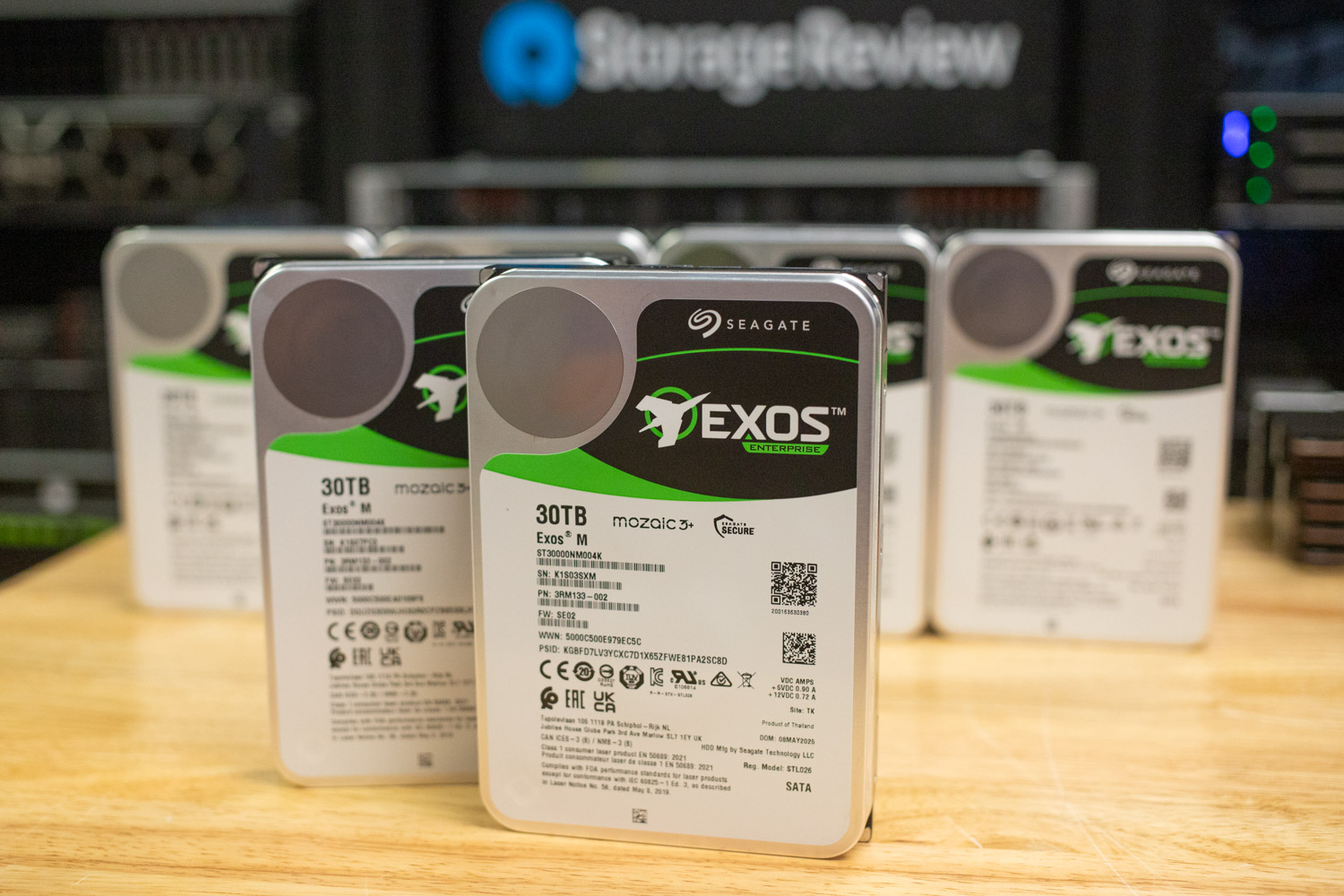
The Exos M 30TB performs on par with Seagate’s previous generation Exos X24 24TB lineup in most scenarios, while offering 25 percent more usable capacity in the same footprint. It also meets the Open Compute Project (OCP) specifications, aligning with standards adopted by major cloud service providers to validate performance readiness at scale.
Best suited for hyperscale deployments, high-density RAID arrays, distributed file systems like Hadoop or Ceph, and enterprise backup environments, the Exos M 30TB delivers a compelling balance of efficiency, capacity, and lifecycle value. Combined with Seagate Secure protection and a five-year warranty, it’s a strong fit for organizations building future-ready infrastructure.
Engage with StorageReview
Newsletter | YouTube | Podcast iTunes/Spotify | Instagram | Twitter | TikTok | RSS Feed

